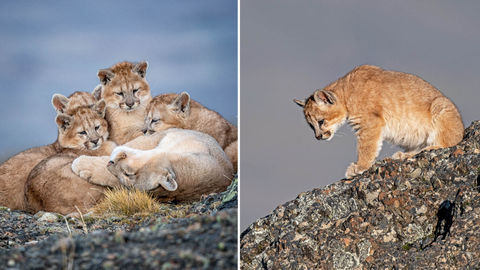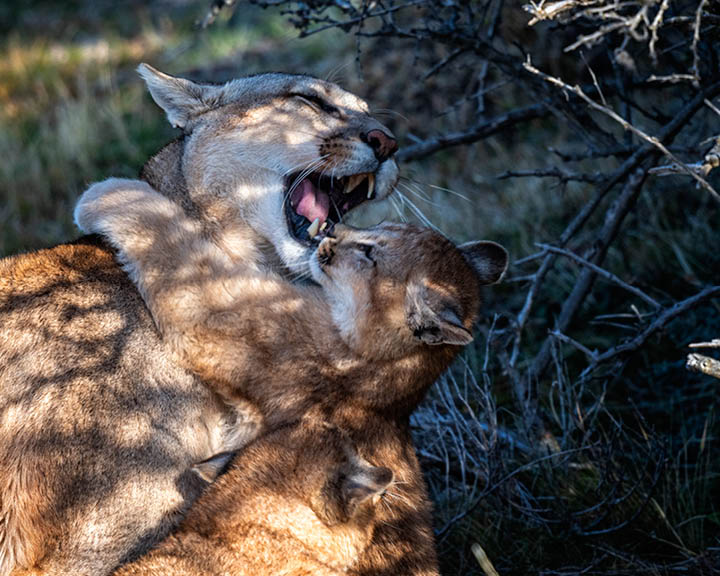
On a trip to the Torres del Paine National Park in Patagonia, Chile, Latika Nath, our contributing wildlife conservationist and photographer walks through a harsh snow-clad landscape with the puma and other wild creatures that call this place home. Text and Images by Latika Nath

On a bucket-list-led trip, I travelled to the southern edge of Chile, merely 180 kilometres from Antarctica. Patagonia is a remote, wild, windswept, and mysterious land at the very tip of the South American continent. It is one of the last great wildernesses on the planet, a place of snow, vast rolling grassy steppes, Andean foothills, and deep fjords and lakes. My quest: to walk with the puma. This powerful predator roams the Americas, where it is also known as panther, cougar, mountain lion, and catamount. Scientists suspect that there is a higher concentration of pumas in Torres del Paine National Park than anywhere else in the world. That’s mostly because there’s plenty of prey (guanacos, hares) here, the cats are protected in the National Park, and lack of competition from other mammalian predators such as wolves.

Like all big-cat photography expeditions, this one required extensive planning. The region is known for its extreme weather conditions—with sub-zero temperatures and icy winds. I went there in the winter, with the possibility of seeing the puma in snow. After nearly 36 hours of travelling, we finally arrived in the port city of Puerto Natales and headed to the Hosteria Pehoe, a small hotel located on the edge of the National Park. It was to be our base for all excursions into puma country for a fortnight. In recent years, wildlife has begun to roam beyond the protection of the park in search of new territory and food. Pumas, in particular, have come under threat by preying on livestock, bringing them into direct conflict with local sheep farmers and estancia owners. Bounties placed on puma skins have also led to a worrying population decline, with the species now at risk of extinction.

To counter the decline, several estancias adjoining the National Park have begun to protect the cats. With the growing sense of security in these spaces, pumas are becoming more comfortable around humans. Pumas don’t roar like lions, and blend into the background. To track the cats, our guide—who had been studying them for over 20 years—had to rely on signs, for instance, the guanacos’ alarm calls and behaviour patterns like panicked running or standing rigid. The flight patterns of vultures or caracaras also help, as they can be used to pinpoint kills. Guanacos and pumas aren’t the only wildlife in Torres del Paine. We came across fluffy grey foxes braving the cold in thick winter coats and a skunk scuttling across the road. The park is also home to more than 100 species of birds. Iconic black and white condors soared overhead; southern caracaras and rare Austral pygmy owls perched on posts; vivid pink flamingos lapped up the nutrients from the Amarga Lagoon; and Darwin’s rheas strutted across the hills.

Over the next few days, with fresh snow blanketing the hills, we tracked, observed, and photographed 17 pumas. Even with several decades of big-cat conservation and photography under my belt, this was a life-changing experience. I had never seen such calm cats, or walked with wild predators at such close proximity.

The first cats I met were a beautiful mother named Rupestre and her four cubs. Racing between shrubs on a wind-blasted slope, I watched four tawny cubs sprint along the mountainside, testing their strength and stalking skills. They tried to imitate their mother, who walked ahead sedately, stopping now and then to assess the situation. At one point, her sister joined the group. When the six of them reached the top of a mountain, the mother and her cubs curled up together and napped, leaving us watching over them for over four hours at a distance of 10-12 feet.

Sitting there, watching the cubs play, it was hard to comprehend that each year in the region, up to 100 pumas are killed by hunters to protect livestock. Human-puma conflict includes retaliatory and pre-emptive killing, exacerbated by mythology perpetuating a fear of the puma. But now, there’s hope. Ranchers are already benefitting from the tourists who pay to watch the puma on their land. If the trend continues, the expected influx of tourism will bring a new lease of life for these incredible cats.



Related: Why Chile Is On Our Bucket List And Deserves To Be On Yours, Too!










